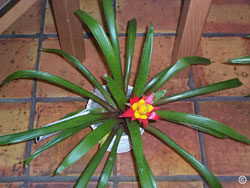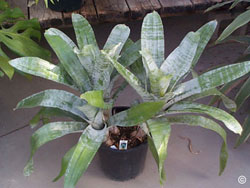The bromeliad is a member of a large plant family that is native to the warmer climates of America. Its two best-known members, pineapples and Spanish moss, give an idea of the diversity of this group of plants. Bromeliads can be found growing in three different ways. Terrestrial species grow with their roots in the ground (like most plants we are familiar with). Saxicolous species are found growing on rocks. Finally, epiphytic species grow on other plants/hosts (usually trees), and get their nutrients from the air around them. Bromeliads vary in size from one inch to 35-feet tall.
Bromeliads have many appealing qualities, but their foliage is generally the most attractive part of the plant. Some bromeliads have several bands or variegations on their leaves, which exhibit different color patterns. Along with their attractive foliage, bromeliads also develop beautiful flowering stalks that are vivid, unique and bold. Pineapple is an example of a fruiting bromeliad.

Bromeliads will survive (but not grow) for many weeks under very low light conditions, but in order to grow well and flower, they need bright light. They will perform the best in a very well-lit area in your home, or you can use artificial light. A bromeliad will indicate whether light levels are satisfactory. A yellowish or pale green plant may indicate that the light level is too high. Conversely, dark green, soft, drooping leaves may be signs that light is too low.
Most bromeliads have a natural reservoir that’s formed by the leaves, which are arranged in a vase-like shape with overlapping bases. Bromeliads should be watered once every week or two, being sure to allow the soil to be dry between waterings. The simplest way to water them is to fill the cup of the plant. Occasionally flush the cup with water to prevent stagnation and to remove the salts left when water in the cup evaporates. Even though they prefer moisture and humidity, bromeliads are extremely tolerant of low-moisture conditions and will survive prolonged periods of drought. Most problems with bromeliads are associated with root rot caused by too much moisture.
Because most bromeliads originated in the tropics, they prefer warm temperatures, and will grow best at 70 degrees Fahrenheit during the day and 55 to 60 degrees Fahrenheit at night. If you keep your plant on a window sill, be sure it’s not touching the window during cold weather.
 Actively growing bromeliads respond to light applications of fertilizer. They require little or no fertilizer during the winter months, or under conditions of low light such as inside a home or office. A general purpose, soluble fertilizer can be applied to the soil of potted bromeliads every 1 to 2 months. Mix the fertilizer in water at 1/3 to 1/2 of the recommended dosage. It is best not to add fertilizer in the center cup because fertilizer salts could accumulate and burn new leaves.
Actively growing bromeliads respond to light applications of fertilizer. They require little or no fertilizer during the winter months, or under conditions of low light such as inside a home or office. A general purpose, soluble fertilizer can be applied to the soil of potted bromeliads every 1 to 2 months. Mix the fertilizer in water at 1/3 to 1/2 of the recommended dosage. It is best not to add fertilizer in the center cup because fertilizer salts could accumulate and burn new leaves.
The potting media should supply moisture to your plant without getting too soggy. The media should also be porous enough to allow water to drain off easily and allow air to reach the roots.
You can force bromeliads to bloom using a healthy, mature plant with a good root system. First, drain all water from the plant and place the plant inside a clear, airtight plastic bag with a large ripe apple. Ripe apples give off a gas called ethylene, which triggers the formation of flowers on bromeliads. After two to three days, remove the plant from the bag and replace the water you removed. Depending on the type of plant you have, flowering will begin in six to fourteen weeks. Many factors affect blooming—plant age, day length, light intensity, water and temperature. Some bromeliads bloom quite regularly while others do not. Bromeliad plants must be mature to flower.
Bromeliads slowly die over a period of a year or two after flowering. However, pups (young plants) usually develop at the base of the “mother” plant. Separate the pups from the mother plant when they are half the size of the parent plant. To start new plants, simply cut the pup off where it attaches to the mother plant and place it in potting soil. The time from the formation of a pup to maturity is approximately one year, but some species take much longer. The foliage of most bromeliads is typically so interesting and/or colorful that the blooms are considered a bonus.



